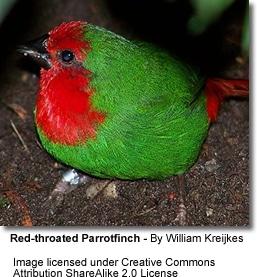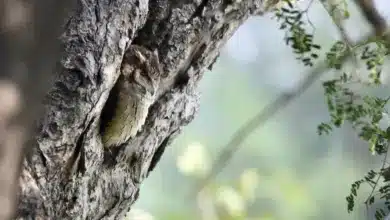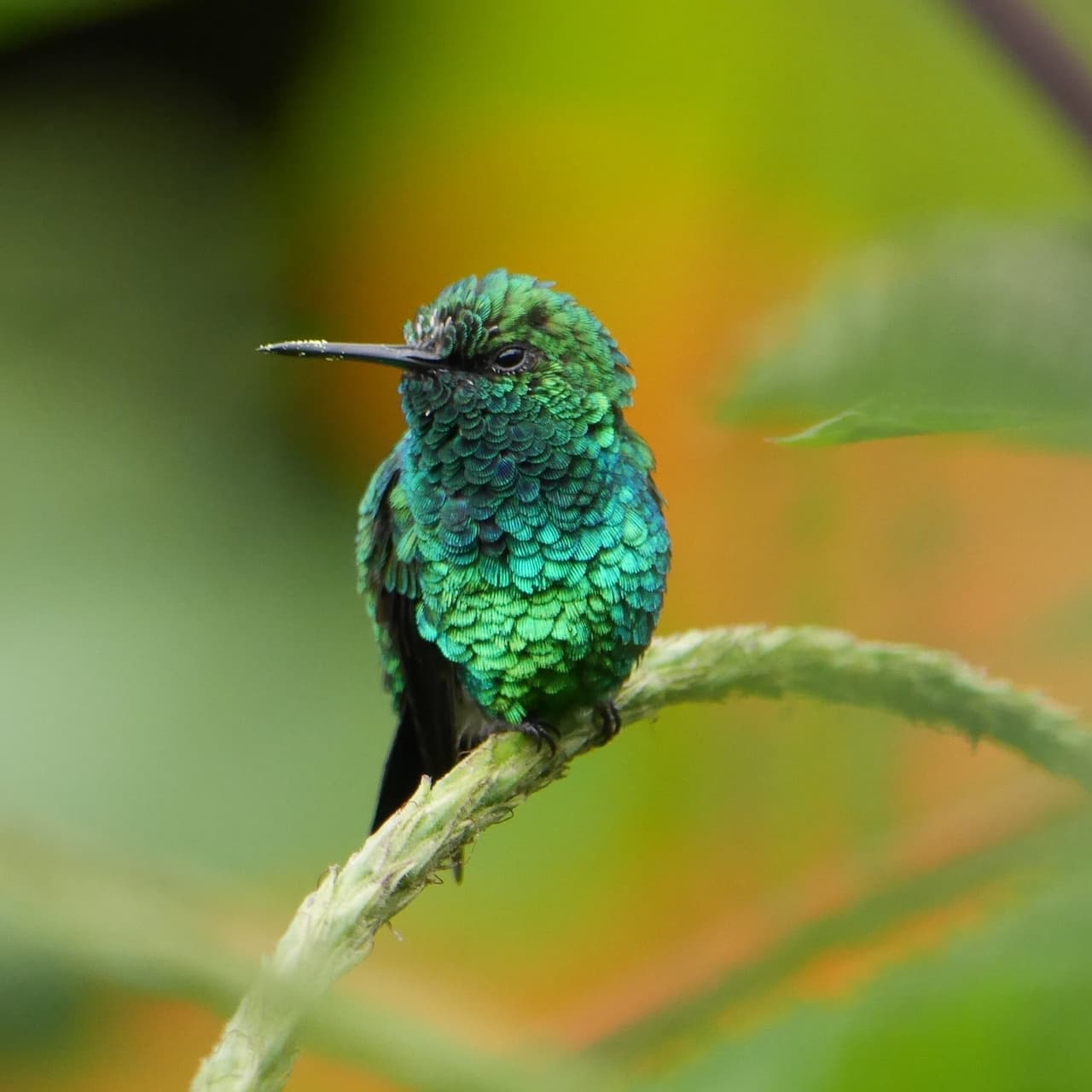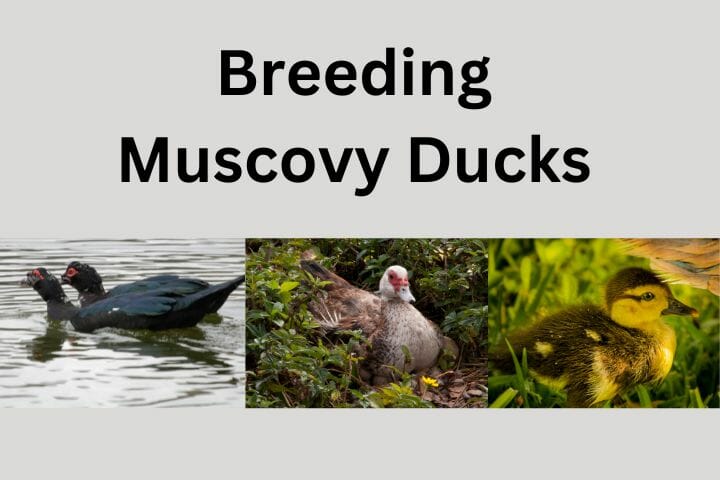Parrot Finch (genus: Erythrura)
The Parrot Finches (genus: Erythrura) are small, very colorful finches that occur naturally from South-east Asia to New Guinea, northern Australia and numerous Pacific Islands.
Within their natural range, they inhabit forests, bamboo thickets and grassland areas. Some have adapted well to urban living and are found on cultivated farmland, in parks and gardens.
Several species are commonly available in aviculture, while others are at risk of extinction because of habitat loss and degradation, namely the Green-faced, Royal and Pink-billed Parrotfinches.
They have become very popular aviary birds, and some beautiful mutations have been bred and are readily available. They are a true delight to have in a mixed aviary or as a colony breeder.
They have a natural inquisitive nature, and seem to have the happy knack of recognizing the breeder immediately and greeting them at the aviary door.
This breed is totally vivacious, very energetic, and always on the move. They are very gentle, which makes them an ideal choice, for a mixed aviary.
This finch loves water — they enjoy jumping in and out of it. Bathing will take place a couple of times a day, summer or winter – and are an important part of their daily grooming.
Another characteristic of the parrotfinches is their almost semi-nocturnal nature. They are always last to roost at night, and can be seen still on the food station, or darting around the aviary when you have the house lights on. Conversely, they are first to stir in the morning.
The pair bonding of the adult birds is very strong, and in the aviary they are seldom seen apart. However, should either one die, a new partner should be introduced as soon as possible.
It is always advisable to have more hens in your colony than male birds, as it minimizes the potential conflict between males.
Description:
The average length of this finch is 12.5 cm / 5 in.
This species is “mono-morphic.” In other words: both sexes look the same in most sub-species.
Experienced breeders will be able to differentiate between the sexes by observation.
With some sub-species, females have a duller plumage and slight color / size differences compared to the male.
The plumage color of most of the sub-species is mostly green. The head, brow and a predominant part of the chest area, is a beautiful crimson scarlet or — if it is a blue-headed parrot finch — blue.
This scarlet or blue area is also carried to rump area of the bird. But instead of being the vivid crimson, tends to be more of a vermilion color.
Fledgling birds tend to be of a dull olive color.
In the nest the youngsters have the most startling iridescent blue “gape” (corners of beak). No doubt, there to help parent birds locate the gaping mouths of chicks, when entering the darkened nest, from the natural light of the aviary.
Parrotfinch Images Gallery
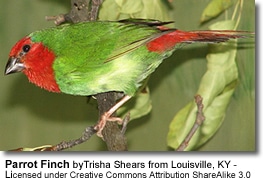
Aviary Requirements:
They are ideally suited for large well-planted aviaries, with plenty of flight space. 8ft. long x 7ft. wide, for example. Give or take a couple of feet. An aviary can never be too big for these active finches.
Provision should be made at the outset to be able to install slotted tracking on the front of the aviary, to slide in either Perspex or Polycarb sheets during the winter months, to keep out the winds, and help keep some heat in.
In talking to some breeders, in the earlier days, cooler climate breeders were plagued with the same problems with the parrot finches, as that faced by gouldian breeders.
Over time the breed has adapted well to cooler climates. However, when purchasing birds from a breeder find out whether the breeder uses artificial heating sources. It takes time for birds to acclimatize to your local temperature and conditions.
It is recommended to provide some cover within the aviary, which can be achieved by planting bushes suitable to your area, or alternatively putting up appropriate brush, which even when dry seems to provide cover adequate for their needs.
Having said all that, give them food, water, and nesting material, and they are likely to thrive and breed. If within your aviary, you have the facility to grow a seeding grass, then you are guaranteeing yourself a happy flock of parrot finches.

Personality / Behavior:
They have a very friendly and inquisitive personality, and grow quite confiding with their caretakers, greeting them enthusiastically at the aviary door as they come in to tend to the flock.
These finches love water. One can frequently see them jump in and out of their bathing dishes. Bathing will take place a couple of times a day, summer or winter – and are an important part of their daily grooming.
Another characteristic of the parrotfinches is their almost semi-nocturnal nature. They are always last to roost at night, and can be seen still on the food station or darting around the aviary when it is getting dark. They are also the first to stir in the morning.
Breeding:
Captive parrotfinches readily accept a wide range of nesting accommodations, from a standard “gouldian” or “budgerigar” nesting box, to a wicker or cane elongated tube.
The nest box should be situated as high in the aviary as possible, although they are willing to settle for a nest box at lower levels.
The hen seems to be the predominant nest builder. Her preferred nesting material includes well-dried pampas grass, soft well-dried grass or teased strands of hessian, cut to manageable lengths.
The hen usually lays between two and six eggs. Fertility rates may be influenced by diet climatic conditions or the individual pair. Both parents share the incubation duties with great dedication. Incubation takes about thirteen to fourteen days.
Parrot Finches are usually tolerant to nest inspection. Should you find a chick or chicks with a skin color that is darker than you would normally expect, this may be indicative of dehydration.
One cause could be lack of green food or live food, such as mealworms or maggots. Lack of bathing opportunities may also create such problems.
The young usually fledge at 21 days. It is within this first week that the fledgling commences to take on the distinctive color of the breed.
These finches tend to be excellent parents – however, it is characteristic of this breed that parents may set up a new nest, and be sitting on a new brood prior to the fledging of the last.
Marker rings should be put on the fledglings when they are about 4 weeks old. Marker rings are an important tool for keeping track of them and for record keeping purposes.

My experience with Parrot Finches:
I owned a lovely family of red-faced parrot finches for several years and remember these little birds very fondly. It was very endearing to see how family-oriented they were.
At one time, as I was carrying soapy water into the aviary for cleaning purposes, one parrot finch managed to fly out of the door.
All day long, he flew around the aviary, and I was very sad knowing that this beautiful (and colorful) little bird would be easy pray out here, and would not make it for long.
In the evening, I went back to the aviary and was surprised to see that the little parrot finch was back in the aviary, except he was in the section where the cockatiels were.
As I was wondering how this was possible, and as I was checking the aviary for any possible means he could have gotten in, I found that I had forgotten to close up the run-off hole (where the cleaning water runs out), which was basically an about 1 inch tube that led to the outside.
The little finch clearly has “crawled itself” back into the aviary, to join his family. And that he did ..
My assessment of them: Beautiful and personable little birds. They don’t breed as prolifically as say the zebras or the societies, but that aspect was never as important to me as their great little personalities. They also make very good parents.
They are not as widely available as other finches, but if you can get them, I would really recommend them for your aviary.
They are beautiful, peaceful, quiet and very endearing birds. In my area, both blue-face and red-face varieties were available. Even though the red-face parrotfinches may be more striking — their personalities should be the same.
Diet:
A good-quality seed mix should be provided, as well as soaked / sprouted seeds, seeding grasses, various greens and live food – especially during the breeding season.
They readily accept fresh fruits / veggies a lot, and greens such as parsley and dandelions. You can get a lot of free “green stuff” (safe, untreated plants please!) from your own garden to feed to them with.
While raising young, breeders often offer additional food items to the parents, such as hard-boiled eggs (potentially enriched with vitamins and minerals – if the diet is less than balanced), as well as sprouted seeds, and mealworms.
Sprouted or germinated seeds are usually more easily accepted by “seed addicts” than fresh fruits and vegetables.
- Sprouted seeds are healthier as the sprouting changes and enhances the nutritional quality and value of seeds and grains. Sprouted seeds are lower in fat, as the process of sprouting utilizes the fat in the seed to start the growing process – thus reducing the fat stored in the seeds.
- Sprouted seeds will help balance your bird’s diet by adding a nutritious supply of high in vegetable proteins, vitamins, minerals, enzymes, and chlorophyll.
- Soaked and germinated “oil” seeds, like niger and rape seeds, are rich in protein and carbohydrates; while “starch” seeds, such as canary and millets, are rich in carbohydrates, but lower in protein.
- It is an invaluable food at all times; however, it is especially important for breeding or molting birds. Sprouted seeds also serve as a great rearing and weaning food as the softened shell is easier to break by chicks and gets them used to the texture of seeds.
The fledglings readily accept live food, such as mealworms. They will take literally any size worm, and if too big to take at once, they will suck the pulp out of the worm.
Green food, on the other hand, takes them about two weeks before they accept it. But once they have gotten used to live food, their appetite is fairly insatiable.
Sprouted seed are readily accepted by birds and are highly nutritious. They make an excellent weaning food..
As with all other breeds, fresh water should be available at all times.
Specific Health Concerns:
As these finches spend a lot of time foraging on the ground, breeders can expect to have to deal with a worm burden.
Some breeders suggest that these finches do not respond well to worming, while others suggest the following protocol: “Mix 80 mils of water, 1.5 mils of Avitrol Plus, 2.0 mils of strawberry topping. The strawberry topping seems to make it more palatable without affecting the efficacy of product.
Use your own judgment on whether or how often to administer. In most cases, 3 or 4 times a year seems appropriate, particularly if you are feeding live food. “
Whether or not such a routine is advisable for your own birds should be discussed with your vet.
Further Finch Reading
- Finch Information
- Index of Finch Species
- Photos of the Different Finch Species for Identification
- Common Health Problems of Finches
- Finch / Canary Diet / Nutrition

